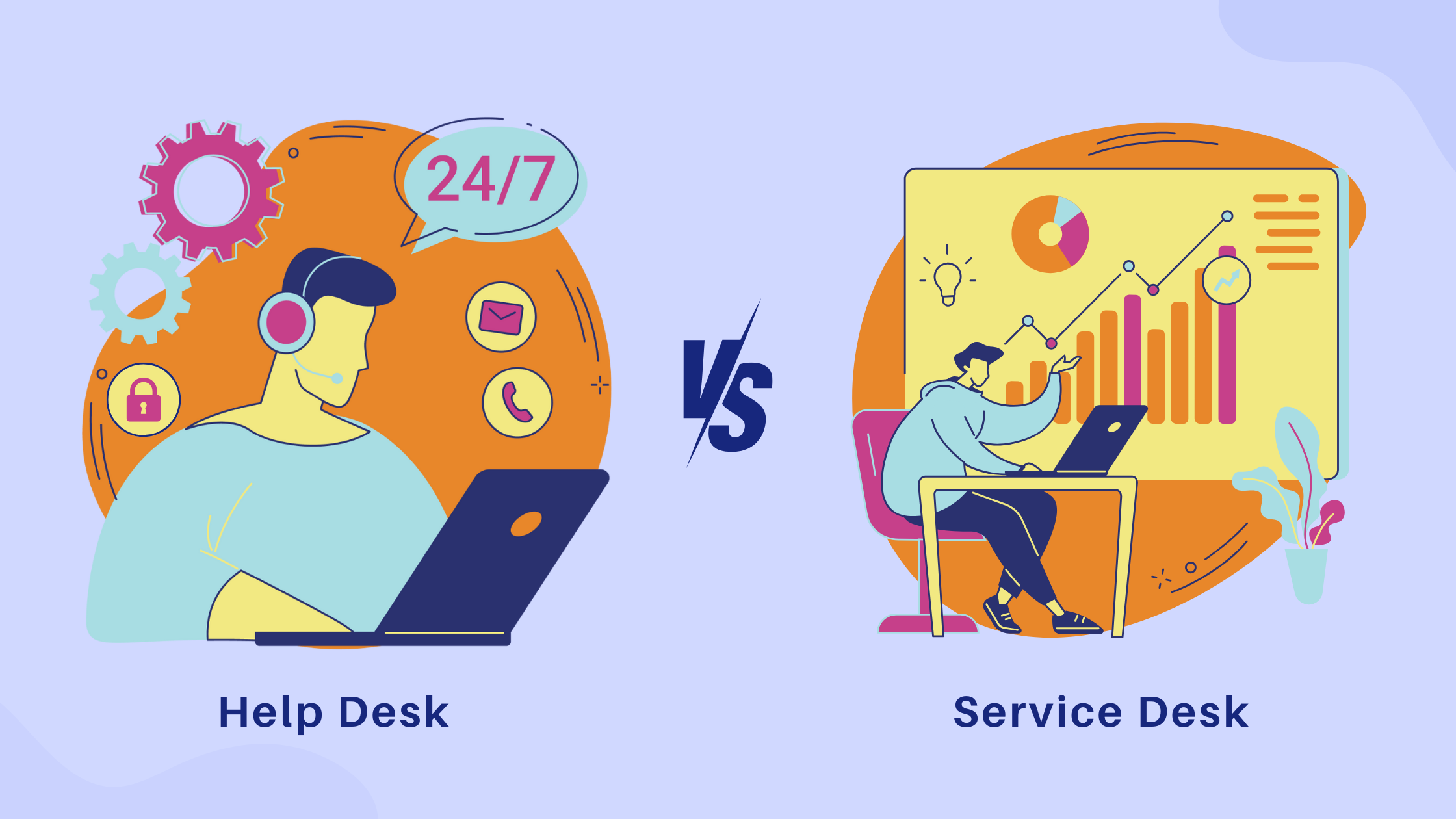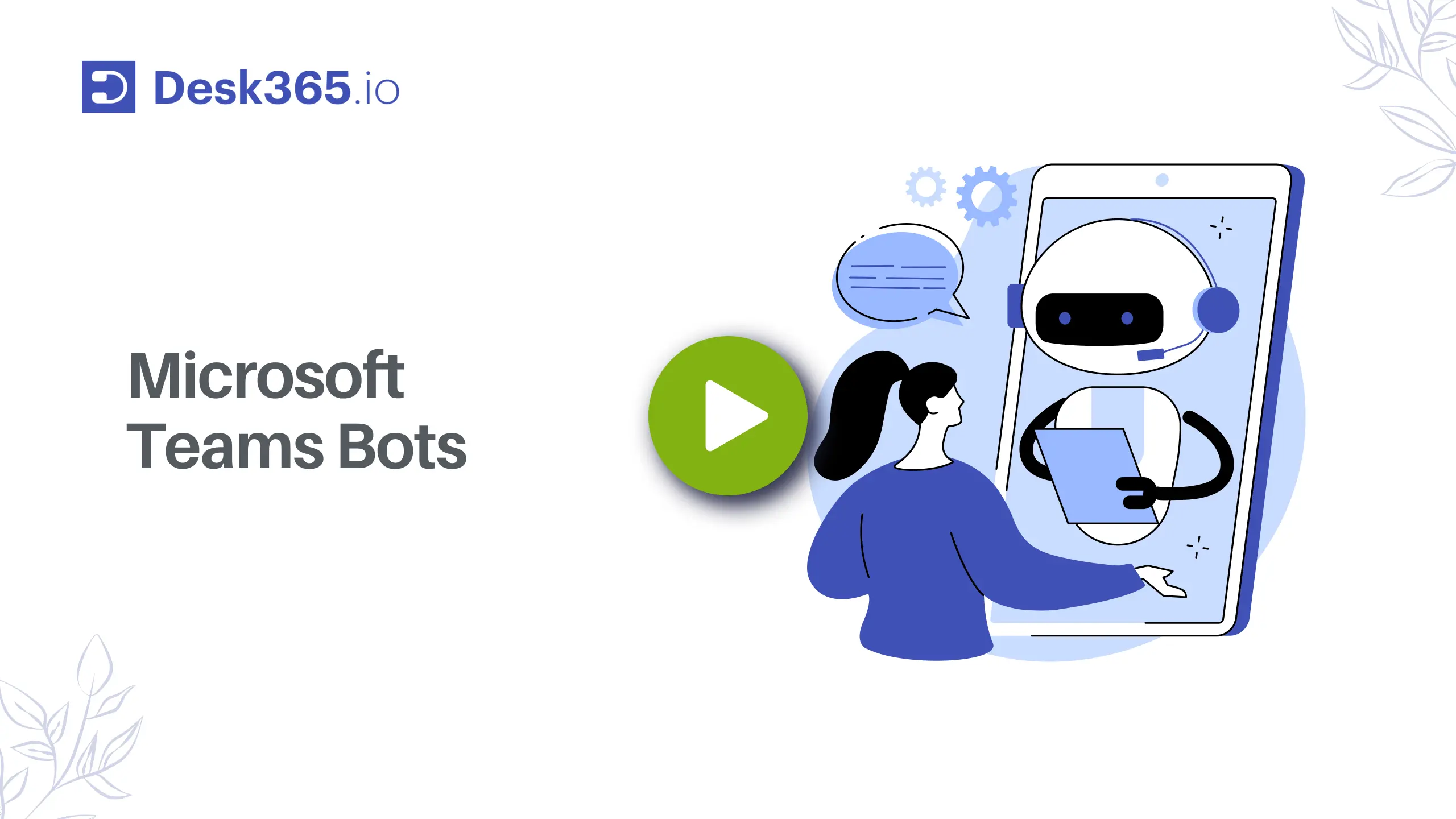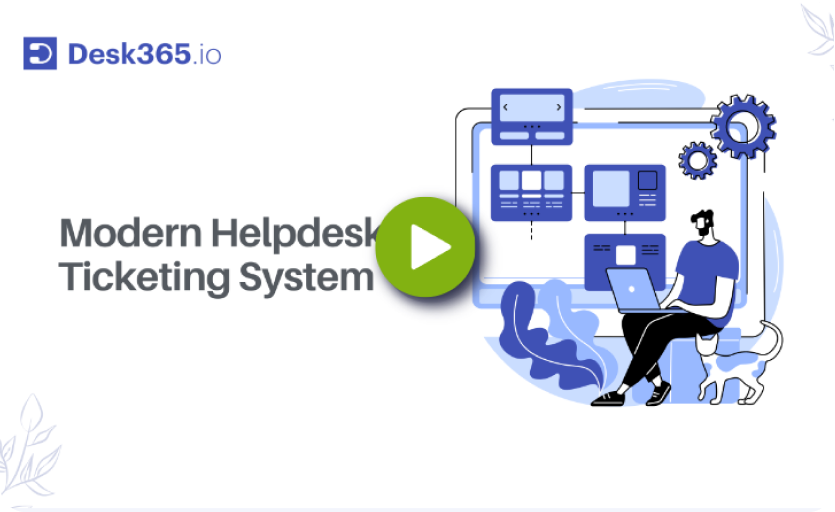Are you dealing with hundreds of customer inquiries every day from across various channels? Does it feel like a big job to track and solve them all? If so, a web help desk software could be the solution you’re seeking. If you’re unsure about what it entails and how it could improve your customer service, this blog post is tailored for you. Beyond just facilitating real-time support, web help desk software automates tasks, streamlining internal support operations regardless of whether your agents operate remotely or from a centralized office.
Let’s dive deep into the web help desk ticketing software, understand how it is different from the on-premises help desk, unfold the crucial features and benefits, get to know how to choose the right web help desk and look at the 10 best web help desk software.
What is a web help desk software?
A web help desk software is a platform accessed through a web browser, primarily designed to aid businesses in managing customer support tickets online. Unlike traditional software that requires installation and frequent updates, a web-based help desk operates entirely over the internet, eliminating the need for periodic installations.
This software serves as a centralized hub for organizing and overseeing customer inquiries, ensuring smooth communication and enhancing the overall customer experience. Key features typically include omni-channel support, a unified inbox for consolidating messages from various sources, automation capabilities, and a comprehensive knowledge base.
One of the significant advantages of web help desk software lies in its cloud-based nature, which makes it highly flexible and scalable. Compared to legacy systems, web-based help desks are less burdened by complex setups and maintenance procedures.
For businesses dealing with a substantial volume of customer inquiries and a distributed team of support agents, web help desk software proves invaluable. It intelligently manages tickets by considering agent availability and automatically assigning tasks, accordingly, optimizing efficiency and response times.
Moreover, these platforms often include self-service features that empower users to troubleshoot and resolve issues independently. By enabling customers to find solutions on their own, ticket volumes are reduced, and support agent productivity is enhanced.
Recommended Reading: How does Ticket Routing help in Customer Service?
How is it different from an on-premises help desk software?
Web help desk software and on-premises help desk software differ significantly in their infrastructure, accessibility, cost structure, scalability, ease of use, and data security.
- Firstly, web help desk software is hosted on the vendor’s servers and can be accessed via a web browser or mobile app, while on-premises help desk software is physically located within an organization’s premises, requiring dedicated infrastructure and maintenance.
- In terms of accessibility, web help desks offer the advantage of being accessible from anywhere with an internet connection, making them ideal for remote teams. Conversely, on-premises help desks can only be accessed within the organization’s internal network, limiting remote access and requiring additional configurations and permissions.
- Cost-wise, web help desk software typically follows a subscription model where users pay for the features they need, resulting in lower upfront costs. On the other hand, on-premises help desks involve higher costs, including infrastructure setup, software licenses, and ongoing maintenance expenses.
- Scalability is another key difference. Web-based help desks can easily scale up by upgrading to a higher plan as the number of users increases, without the need for additional infrastructure. However, scaling up an on-premises help desk can be costly and complex, requiring additional infrastructure and licensing investments.
- In terms of efficiency and convenience, web help desk software can be accessed instantly from a web browser without the need for installation, ensuring that teams always have access to the latest version. Conversely, on-premises software often requires manual downloads and updates.
- One of the critical advantages of web help desks is data security. They typically employ top-tier data centers to ensure data security, eliminating the need for an in-house IT support team and reducing costs associated with data security measures.
Both web help desk and on-premises help desk software serve similar purposes, they differ significantly in infrastructure, accessibility, cost, scalability, ease of use, and data security, making each suitable for different organizational needs and preferences.
Key features of a web help desk software
Web help desk software comes equipped with several key features that are essential for efficiently managing customer support tickets and enhancing overall service quality. They work together to streamline ticket management, empower self-service resolution, uphold SLAs, provide insights through reporting, and facilitate efficient incident management, ultimately enhancing the overall customer support experience.
Centralized dashboard
A centralized dashboard serves as the nerve center of the web help desk software, allowing agents to manage service tickets from various channels in one unified interface. Whether it’s a small organization or a large enterprise, a centralized dashboard offers flexibility and convenience by providing a comprehensive view of all support activities.
Streamlined ticket management
This feature simplifies and streamlines the ticketing process, starting from ticket creation to resolution. It enables users to automate ticket assignments and management tasks, ensuring efficient handling of customer inquiries. Real-time notifications and alerts keep agents informed and ensure timely responses to customer queries.
Knowledge base
Web help desk software typically includes a built-in knowledge base, which serves as a repository of information and solutions for common customer issues. This empowers end-users to find resolutions independently, reducing the volume of ticket requests and enhancing customer satisfaction. Additionally, it enables support agents to quickly access relevant information to resolve inquiries more efficiently.
SLA tracking and management
Service Level Agreement (SLA) tracking and management features ensure that all service level agreements are upheld and met. SLAs help agents to stay on top of deadlines and commitments, ensuring customer expectations are consistently met.
Help desk reporting
Web help desk software provides robust reporting capabilities to monitor and track various aspects of ticket management. Users can generate reports to analyze ticket statuses, review agent performance metrics, identify trends, and gain insights into overall support operations. These reports help in optimizing processes, identifying areas for improvement, and making data-driven decisions to enhance customer service quality.
Incident management
Incident management features simplify the process of handling and resolving customer incidents. This ensures effective ticket management and resolution by addressing underlying issues comprehensively. By consolidating related incidents, web help desk software enables efficient problem-solving and minimizes customer disruptions.
Ready to Elevate Your Customer Support?
Simplify your support process and deliver exceptional service with Desk365’s web help desk software. Experience the ease of ticket management, automation, and omnichannel support—all in one powerful platform. Try Desk365 today!
Benefits of using a web help desk software
Using a web help desk software offers a range of benefits for both support agents and customers:
Remote accessibility
One of the primary advantages of web help desk software is the ability for agents to provide support to end-users anytime, from anywhere, using just a web browser. This flexibility enables support teams to address customer queries promptly, regardless of their physical location. Whether agents are working from home, on the go, or in the office, they can easily access the help desk platform to assist customers efficiently.
Efficient customer query management
With a web help desk, organizations can ensure that every customer query is promptly addressed and resolved. The centralized nature of the software allows support teams to stay on top of incoming tickets, prioritize urgent issues, and manage workflows effectively. By providing a streamlined ticketing system, web help desk software helps prevent queries from being skipped, ensuring a high level of customer satisfaction.
Empowerment through self-service
Web help desk software empowers customers to find answers to their queries independently. By offering a robust knowledge base filled with articles, FAQs, troubleshooting guides, and other resources, organizations can guide customers through common issues and help them resolve problems on their own. This not only reduces the workload for support agents but also enhances the customer experience by providing quick and accessible solutions to common queries.
Recommended Reading: 8 Best Customer Self-Service Portals
How to choose the right web help desk software?
Selecting the right web help desk software is crucial for optimizing customer support. Here are some tips to help you choose the best option:
Assess team size and ticket volume
Consider the size of your support team and the volume of incoming tickets. Choose a web help desk solution that can efficiently handle your team’s workload and scale as your support operations grow.
Industry-specific needs
Ensure that the web help desk caters to the specific needs of your industry. Look for features and functionalities tailored to your sector.
Integration capabilities
Check if the web help desk integrates seamlessly with your existing systems and tools. Integration with CRM software, communication platforms, and other essential applications can streamline workflows and improve efficiency.
Feature evaluation
Evaluate the features offered by the web help desk and ensure that it meets your requirements. Look for essential functionalities like ticket management, automation, reporting, knowledge base, and omnichannel support to effectively handle customer inquiries.
Free trial availability
Opt for a web help desk that offers a free trial period. This allows you to test the software firsthand and determine if it aligns with your expectations and workflow needs before making a commitment.
Scalability
Choose a web help desk software that can scale alongside your business. Ensure that it can accommodate future growth in terms of team size, ticket volume, and customer support channels without compromising performance or functionality.
Value for money
Lastly, ensure that the chosen web help desk offers value for money. Consider factors such as pricing plans, feature offerings, support services, and overall return on investment to make an informed decision.
10 best web help desk software's
With so many web-based helpdesk software available, choosing the right one can make all the difference in managing customer interactions effectively. We’ll delve into the features of 10 leading platforms. Let’s explore how each of these tools stands in the competitive landscape of help desk software.
1. Desk365
Key features
Unified inbox: One of Desk365’s standout features is its shared inbox, allowing multiple team members to access and manage customer emails from a centralized interface. This ensures that no query goes unnoticed, and all inquiries receive timely responses.
Omnichannel support: Desk365 supports various channels including Microsoft Teams, email, customer support portal, web widget, and web form, making it easy for customers to reach out through their preferred channels.
Ticket management: Desk365 simplifies ticket creation and ticket assignment, ensuring that every customer query is directed to the right support agent for resolution. The platform’s categorization and prioritization features enable teams to manage tickets effectively and allocate resources accordingly.
SLA capabilities: Desk365’s SLA management feature ensures timely responses and resolutions by setting up reminders and escalation rules. This helps maintain accountability and transparency throughout the support process.
Collaboration tools: Collaboration is facilitated seamlessly within Desk365, allowing team members to work together on customer issues, share private notes, and provide feedback. This promotes knowledge sharing and enhances problem-solving capabilities.
Automation: Desk365’s automation feature streamlines workflows by automating repetitive tasks such as ticket assignment and notifications. This reduces manual effort and ensures smooth support operations.
APIs, webhooks & connectors: Desk365 integrates with in-house or third-party apps and services using its API/Webhook or the Desk365 Power Automate connector extending the platform’s capabilities.
Instant notifications: Agents receive instant notifications via email and the web for ticket replies and other activities, ensuring timely responses and updates. Desk365 Agent Bot also provides push notifications on Microsoft Teams.
Canned responses: Agents can create canned responses, facilitating quick responses to routine requests and improving efficiency.
Custom views: Custom ticket views can be created to suit specific requirements, providing quick access to relevant information. These views can be saved and analyzed for better insights.
Customization: Desk365 can be customized to suit specific needs, including support portal customization, custom agent roles, custom ticket forms, custom Teams support bot, custom ticket views, and custom email servers.
Reporting and analytics: Desk365 provides valuable insights through its reporting and analytics features, allowing teams to track key metrics and identify areas for improvement. This data-driven approach helps optimize support workflows and enhance overall customer satisfaction.
Pricing plan:
- Lowest paid plan: $12/agent/month
- Highest paid plan: $20/agent/month
2. Help Scout
Help Scout is renowned for its simplicity and versatility in managing customer interactions. With built-in tools like a knowledge base and live chat, Help Scout offers a seamless support experience for both businesses and customers alike.
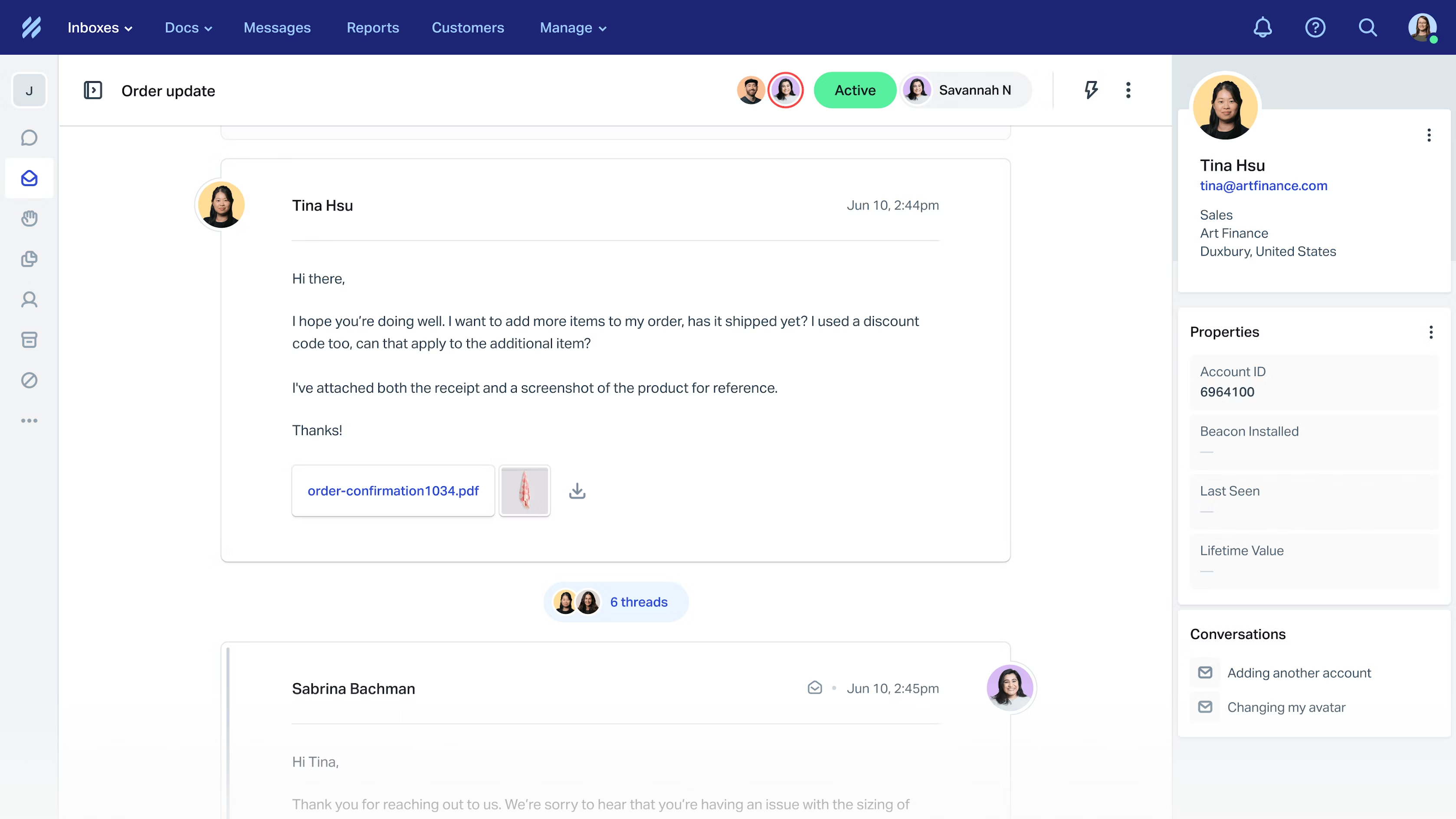
Key features
Customizable workflows: Help Scout allows teams to tailor workflows to match their specific processes and needs. This flexibility enables businesses to adapt the platform to their unique support requirements.
Live chat: Help Scout’s live chat feature, helps engage with customers in real-time providing immediate assistance and fostering customer satisfaction.
Knowledge base: Help Scout offers a comprehensive knowledge base for self-service support, empowering customers to find solutions to their queries independently.
Rule-based automation: Help Scout’s automation capabilities ensure that support processes run smoothly and effectively. Automating repetitive tasks based on predefined rules helps save time and enhances efficiency.
Robust analytics: Managers and agents can gain insights into the teams performance and customer satisfaction with comprehensive analytics. This allows businesses to track progress, identify trends, and make data-driven decisions to improve support quality.
Pricing plan:
- Lowest paid plan: $20/agent/month
- Highest paid plan: $65/agent/month
3. Freshdesk
Freshdesk stands out as a versatile help desk software solution tailored to meet diverse customer support requirements. With a comprehensive array of features and intuitive interface, Freshdesk empowers businesses to deliver exceptional support experiences seamlessly.
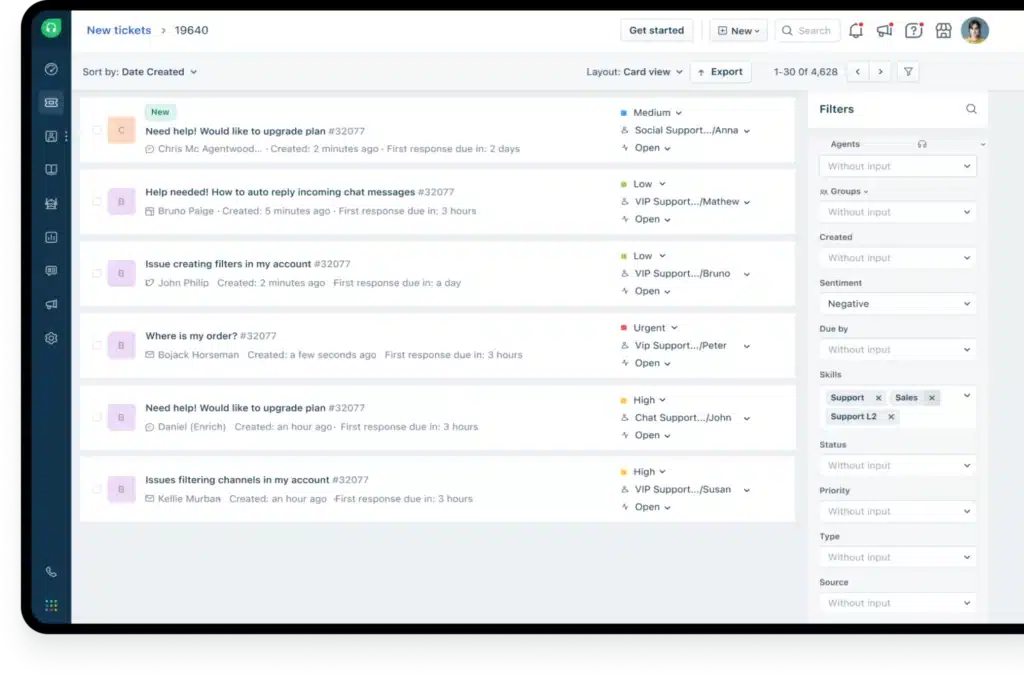
Key features
Multi-channel support: Freshdesk enables interaction with customers across multiple channels, including email, chat, and social media, all from a unified platform. This consolidated approach ensures efficient communication and streamlines support processes.
Shared inbox: Facilitating team collaboration, Freshdesk’s shared inbox allows agents to work together seamlessly, ensuring prompt and coordinated responses to customer queries. This collaborative environment enhances efficiency and customer satisfaction.
Ticket management and workflow automation: Freshdesk simplifies customer interactions with robust ticket management and workflow automation capabilities. By automating repetitive tasks, teams can focus on resolving customer issues promptly, enhancing productivity and service quality.
Self-service portal: Freshdesk empowers customers to find solutions independently through its self-service portal. By providing access to a knowledge base and FAQs, businesses can enable customers to resolve common queries on their own, reducing support ticket volumes and improving customer satisfaction.
Advanced reporting and analytics: Freshdesk offers advanced reporting and analysis tools, providing insights into support operations and customer satisfaction levels. By tracking key metrics and trends, businesses can identify areas for improvement and make data-driven decisions to enhance overall service quality.
Pricing plan:
- Lowest paid plan: $1199/agent/month
- Highest paid plan: $6899/agent/month
4. HappyFox
HappyFox emerges as a user-friendly help desk software solution that enables businesses to streamline their customer support operations effectively.
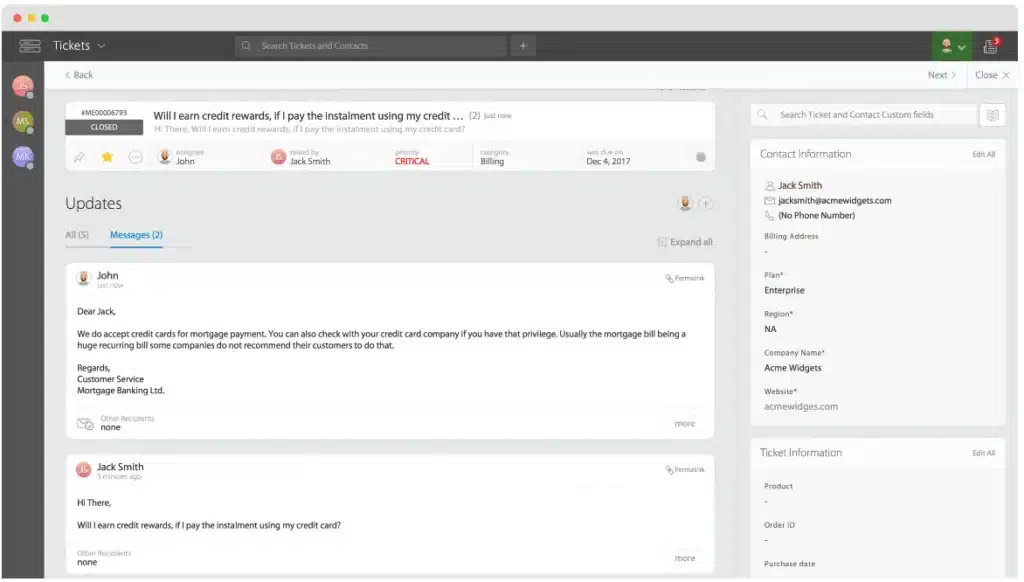
Key features
Workflow macros: Simplifies support processes with workflow macros that automate repetitive tasks. By creating predefined actions for common scenarios, teams can save time and ensure consistency in their support interactions.
Live chat: Happy Fox offers a live chat feature that enables immediate assistance and engagement. This real-time communication channel enhances customer satisfaction by addressing queries promptly.
Ticket routing, categorization, and tagging: Empowers teams with robust ticket management capabilities, including ticket routing, categorization, and tagging. By organizing and prioritizing tickets effectively, teams can optimize their support workflows and ensure timely resolutions.
Omnichannel support: Allows businesses to engage with customers across various channels such as email, chat, and social media. This multichannel approach ensures seamless communication and enhances the overall support experience.
Knowledge base: Happy Fox offers a self-service knowledge base, enabling customers to find answers to their queries independently. By providing access to informative resources, businesses can reduce support ticket volumes and empower customers to resolve issues on their own.
Automation tools: It streamlines support operations with automation tools that automate repetitive tasks and processes. By automating routine actions, teams can improve efficiency and focus on delivering high-quality support.
Reports and analytics: Happy Fox provides robust reporting and analytics tools, allowing businesses to track performance metrics and gain insights into customer satisfaction levels. By analyzing key metrics, teams can identify trends, areas for improvement, and make data-driven decisions to enhance support quality.
Pricing plan:
- Lowest paid plan: $39/agent/month
- Highest paid plan: $99/agent/month
Recommended Reading: HappyFox vs. Zendesk: Which Ticketing Software is Best for You in 2025?
5. Spiceworks
Spiceworks offers a free IT help desk solution tailored to simplify the management of IT-related tasks, particularly ideal for small businesses. With a range of features designed to streamline support processes, Spiceworks empowers businesses to effectively manage support requests, track hardware and software assets, and analyze performance—all without the burden of subscription fees.
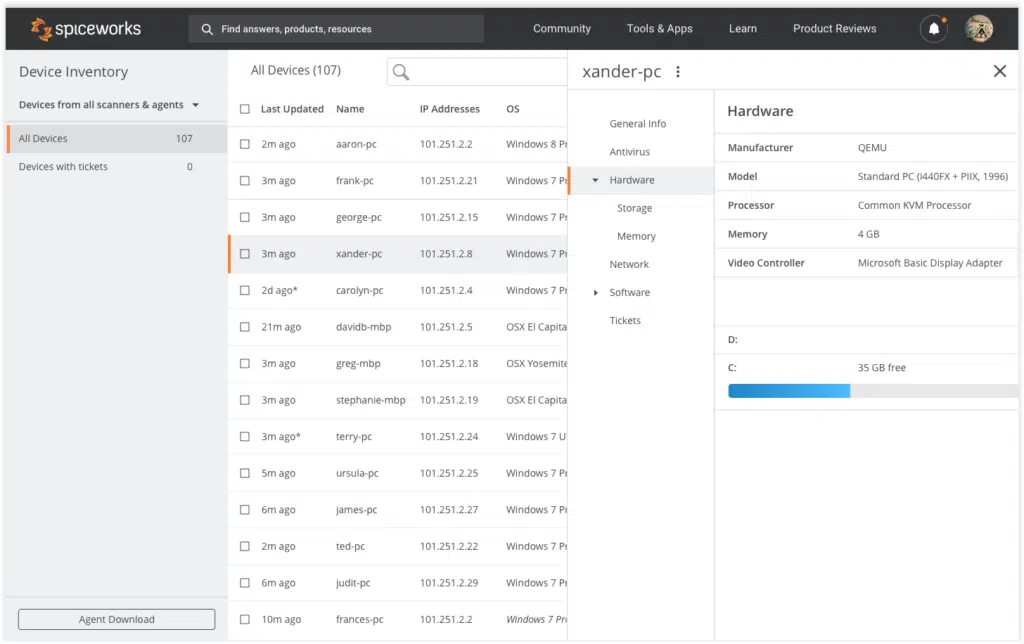
Key features
Ticketing system: Spiceworks provides a robust ticketing system for managing support requests efficiently. This feature allows businesses to track, prioritize, and resolve IT issues promptly, ensuring minimal disruption to operations.
Self-service portal: The self-service portal empowers end-users to submit new tickets and track the progress of existing ones without constant communication with support teams. By providing access to a knowledge base, Spiceworks saves time for both users and support staff.
Automation tools: Spiceworks includes automation capabilities to streamline workflows and reduce manual effort. By automating routine tasks such as ticket assignment and notifications, businesses can improve efficiency and focus on strategic IT initiatives.
Asset management: It offers asset management functionality to track hardware and software assets effectively. This feature enables businesses to maintain an accurate inventory of their IT resources, facilitating better decision-making and resource allocation.
Reporting tools: Spiceworks provides reporting tools for performance analysis, allowing businesses to gain insights into support operations and identify areas for improvement. By analyzing key metrics, such as response times and ticket resolution rates, businesses can optimize their support processes and enhance overall efficiency.
Customization: The help desk allows for customization to tailor the help desk solution to specific business needs. This flexibility enables businesses to adapt the platform to their unique requirements and workflows, ensuring a personalized support experience.
Collaboration: The web based help desk facilitates collaboration among support teams, enabling seamless communication and knowledge sharing. By providing tools for team collaboration, businesses can enhance productivity and problem-solving capabilities.
Remote support: Spiceworks offers remote support capabilities, allowing IT teams to troubleshoot and resolve issues remotely. This feature enables businesses to address IT issues quickly and efficiently, regardless of the location of the end-user.
Pricing plan:
- Lowest paid plan: Free
- Highest paid plan: Free
6. Jira
Jira by Atlassian is a widely recognized platform utilized for bug tracking, issue tracking, and project management. With its comprehensive set of features, JIRA enables teams to streamline workflows, enhance communication, and gain valuable insights through reporting capabilities.
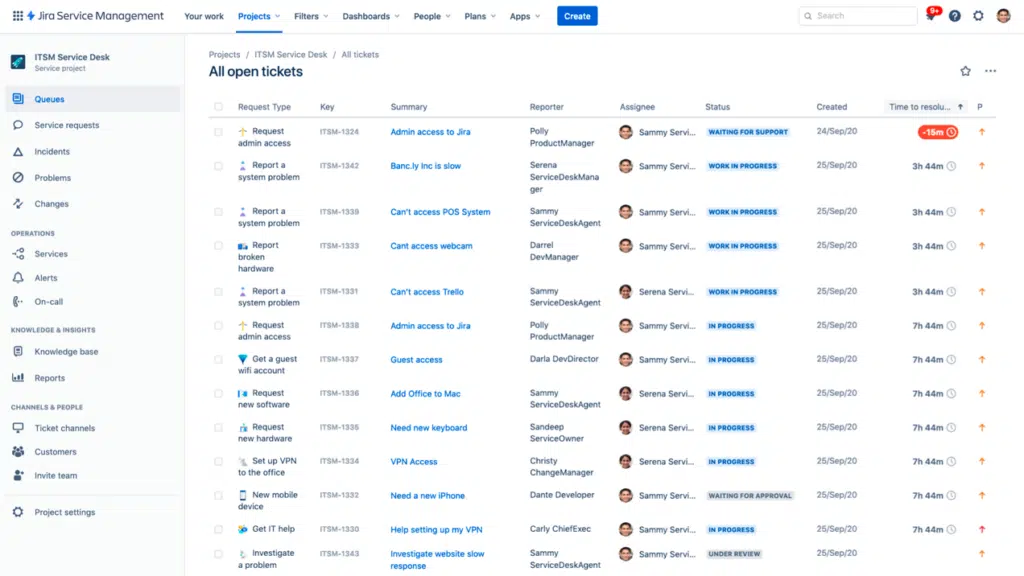
Key features
Service automation: JIRA offers service automation capabilities to streamline workflows and reduce manual tasks. By automating routine processes, teams can improve efficiency and focus on delivering high-quality outcomes.
Service desk chat: JIRA provides a service desk chat feature for real-time communication, facilitating quick collaboration and issue resolution. This real-time communication channel enhances productivity and ensures timely responses to customer inquiries.
Comprehensive service desk reporting: JIRA offers comprehensive reporting tools for the service desk, allowing teams to gain insights into performance metrics and track key indicators. By analyzing service desk data, teams can identify trends, monitor progress, and make data-driven decisions to improve service quality.
Pricing plan:
- Lowest paid plan: $7.16/agent/month
- Highest paid plan: $12.48/agent/month
7. Salesforce
Salesforce offers a comprehensive customer relationship management (CRM) tool with robust help desk functionality through its Service Cloud platform. Tailored for enterprise businesses with complex needs, Salesforce provides a cloud-based solution for managing customer interactions across various channels effectively.
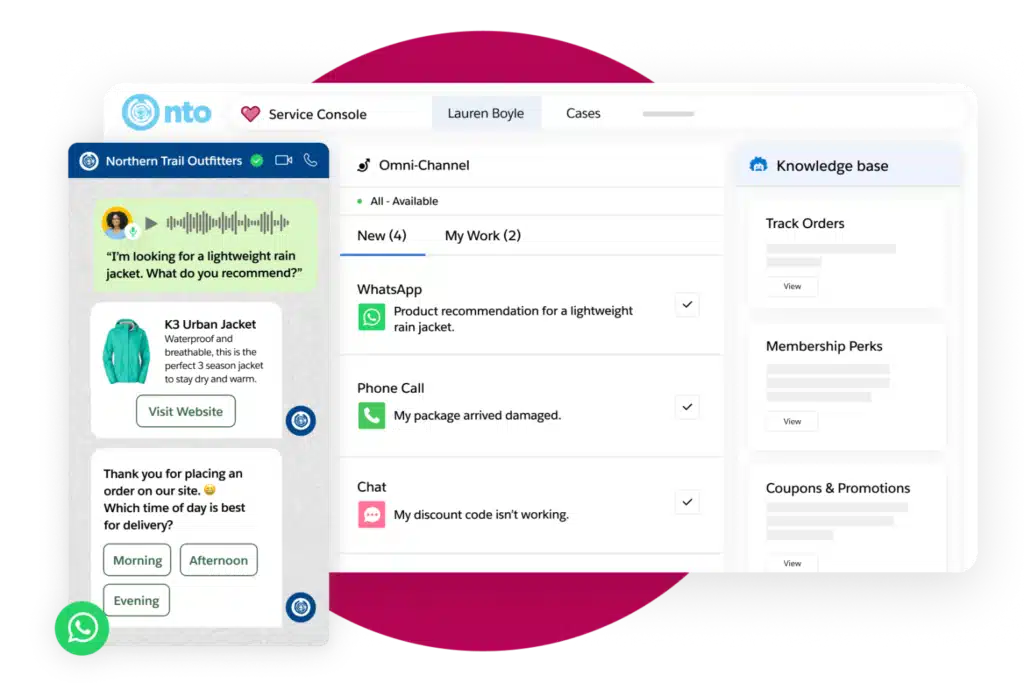
Key features
SLA management: Salesforce Service Cloud includes SLA management capabilities to ensure timely responses and resolutions to customer inquiries. This feature helps businesses uphold service level commitments and maintain high customer satisfaction levels.
Asset management: With asset management functionality, Salesforce Service Cloud enables businesses to track and manage resources efficiently. This feature allows organizations to maintain an accurate inventory of assets, ensuring optimal utilization and maintenance.
Email automation: Salesforce Service Cloud offers email automation features for efficient communication with customers. By automating email responses and workflows, businesses can streamline communication processes and improve response times.
In-depth help desk reporting: Salesforce Service Cloud provides in-depth reporting tools for the help desk, allowing businesses to gain insights into support operations and customer interactions. By analyzing help desk data, organizations can identify trends, monitor performance, and make data-driven decisions to enhance service quality.
Pricing plan:
- Lowest paid plan: $24/agent/month
- Highest paid plan: $165/agent/month
8. SysAid
SysAid offers a robust IT service management solution designed to simplify the work of IT teams through a variety of tools and features. With comprehensive ticket and workflow automation, self-service portals, asset management, SLA management, and integration capabilities, SysAid empowers organizations to streamline IT processes and enhance service delivery.
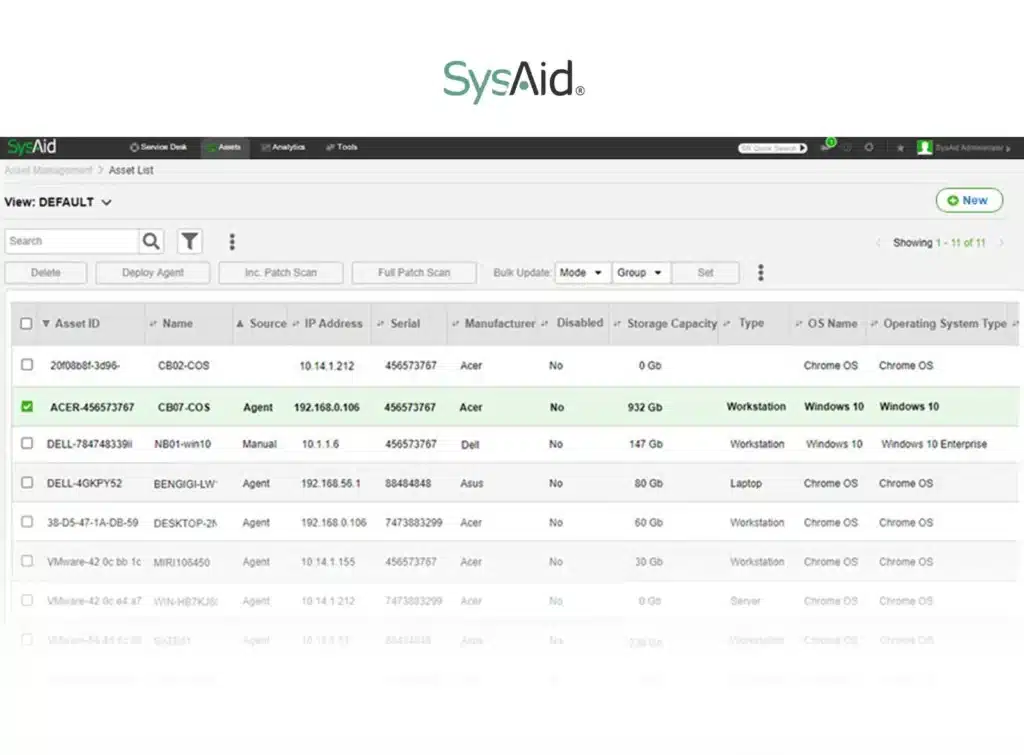
Key features
Comprehensive ticket and workflow automation: SysAid provides comprehensive ticket and workflow automation features to streamline IT processes. By automating routine tasks and workflows, IT teams can improve efficiency and focus on delivering high-quality support to end-users.
Self-service portal: SysAid includes a self-service portal that allows end-users to resolve their own IT issues and access relevant information. This feature reduces the workload on IT teams and empowers end-users to find solutions independently, enhancing overall productivity.
Asset management: With asset management functionality, SysAid enables organizations to keep track of all hardware and software assets. This feature helps IT teams maintain an accurate inventory of assets, optimize resource allocation, and ensure compliance with licensing agreements.
SLA management: SysAid offers SLA management capabilities to ensure timely resolution of IT issues. By defining and monitoring service level agreements, organizations can prioritize tasks, meet performance targets, and enhance customer satisfaction.
Variety of templates and forms: SysAid provides a variety of templates and forms with customization options to suit specific organizational needs. This flexibility allows organizations to adapt the platform to their unique requirements and workflows, ensuring a personalized IT service management experience.
Integration with third-party tools and systems: SysAid offers seamless integration with various third-party tools and systems, enhancing interoperability and extending the platform’s capabilities. This integration capability allows organizations to leverage existing investments and streamline IT operations.
Integrates with Microsoft Teams: The SysAid Teams ticketing system integrates seamlessly with Microsoft Teams, providing a comprehensive solution for managing IT support tickets directly within the Teams environment. With features such as automatic notifications, approval notifications, user availability status, escalation and routing rules, and email integration, SysAid for Microsoft Teams enhances collaboration and communication among IT teams.
9. Hiver
Hiver revolutionizes the Gmail experience by turning it into a collaborative hub, especially beneficial for teams heavily reliant on email for communication and support. By leveraging the familiar interface of Gmail, Hiver provides a seamless and efficient solution for managing customer support operations directly within the inbox.
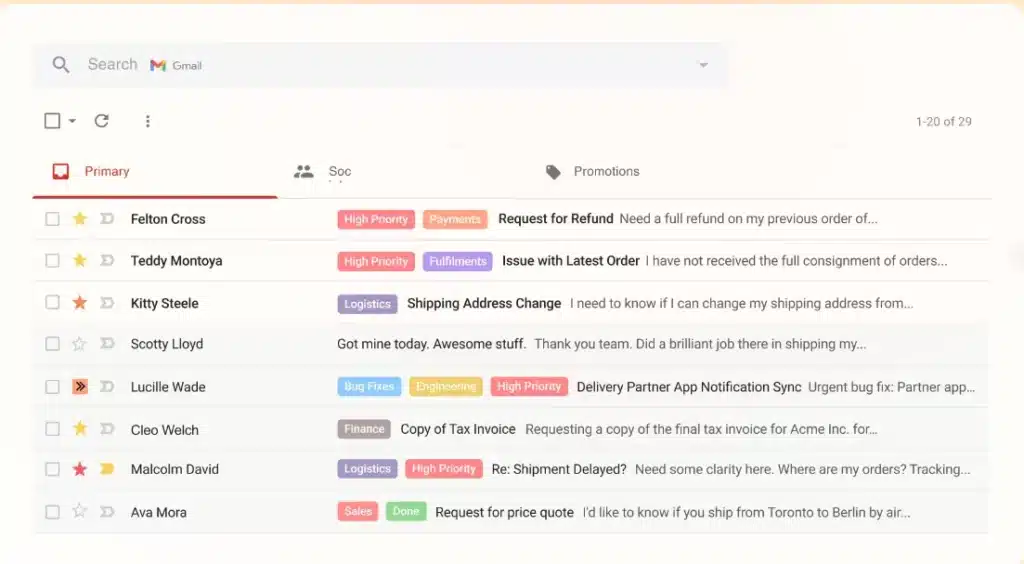
Key features
Email assignment: Hiver facilitates email assignment to distribute conversations to specific agents, ensuring efficient allocation of tasks and responsibilities within the team. This feature streamlines ticket management and enhances accountability.
Internal notes: With internal notes functionality, Hiver allows for collaboration without leaving the Gmail interface. Team members can communicate, share insights, and collaborate on customer inquiries seamlessly, enhancing productivity and problem-solving capabilities.
Reporting tools: Hiver provides robust reporting tools to track performance and customer satisfaction metrics. By analyzing key metrics such as response times and resolution rates, businesses can gain insights into their support operations and make data-driven decisions to improve efficiency and service quality.
Knowledge base: Hiver offers a knowledge base for self-service support, empowering customers to find answers to their queries independently. This feature reduces support ticket volumes and empowers customers to resolve issues quickly, enhancing overall satisfaction.
Integration with Other tools and services: Hiver seamlessly integrates with other tools and services, extending its capabilities and enhancing interoperability. This integration capability allows businesses to leverage existing investments and streamline their support processes further.
SLAs (Service Level Agreements): Hiver includes SLA management features to ensure timely responses and resolutions to customer inquiries. By defining and monitoring SLAs, businesses can prioritize tasks and meet service level commitments, enhancing customer satisfaction.
Pricing plan:
- Lowest paid plan: $19/agent/month
- Highest paid plan: $99/agent/month
10. Zoho Desk
Zoho Desk stands as a comprehensive support solution, consolidating various customer service tools under one roof for streamlined management. As a cloud-based customer service platform, Zoho Desk equips businesses with an array of features aimed at enhancing support operations and improving customer satisfaction.
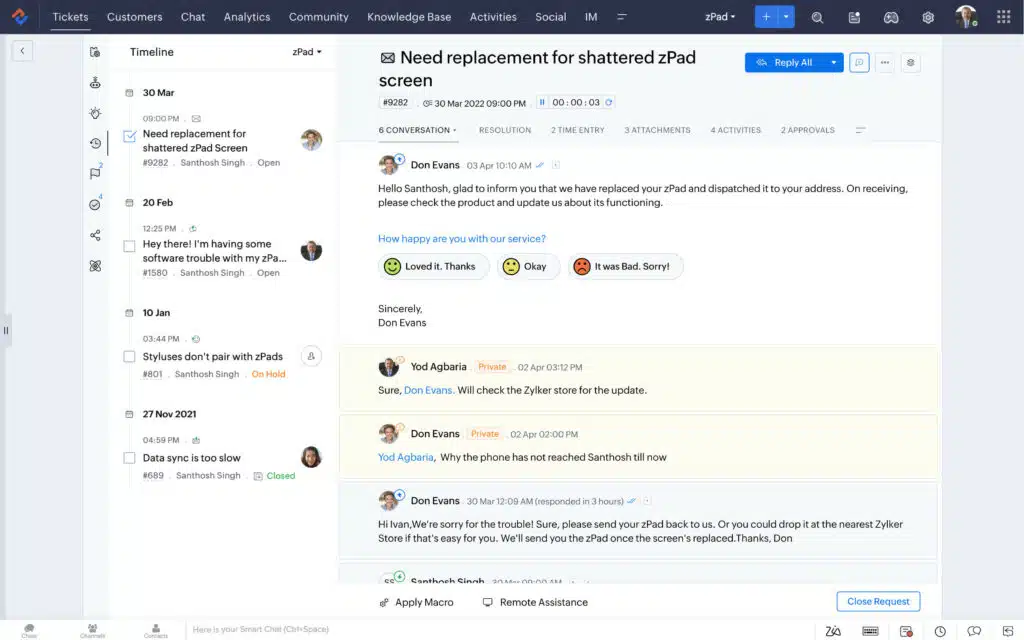
Key features
Shared inbox: Zoho Desk provides a shared inbox for managing customer interactions, facilitating collaboration and ensuring that customer inquiries are addressed promptly. This centralized inbox streamlines communication and enables teams to provide consistent and efficient support.
AI-assisted responses: With AI-assisted responses, Zoho Desk automates and expedites support by providing intelligent suggestions and responses to common customer queries. This feature enhances response times and enables teams to handle a higher volume of inquiries effectively.
Advanced automation: Zoho Desk offers advanced automation capabilities for conversation sorting and tagging, allowing teams to automate repetitive tasks and streamline workflows. By automating routine processes, businesses can improve efficiency and focus on delivering personalized support to customers.
Integration: Zoho Desk integrates seamlessly with other Zoho products and various third-party tools, extending its capabilities and enhancing interoperability. This integration capability enables businesses to leverage existing tools and systems, streamlining their support operations further.
Knowledge base: Zoho Desk features a knowledge base for self-service support, empowering customers to find answers to their queries independently. By providing access to relevant articles and resources, businesses can reduce support ticket volumes and enhance customer satisfaction.
Pricing plan:
- Lowest paid plan: $19/agent/month
- Highest paid plan: $99/agent/month
Choosing the right web help desk ticketing software is essential for businesses looking to streamline their customer support operations effectively. By understanding the key features, benefits, and differences between web-based and on-premises help desk solutions, organizations can make informed decisions that align with their unique needs and preferences.
Invest in the right web help desk software and enhance customer satisfaction, improve support team productivity, and drive business success.
Try Desk365 for free and see the difference it makes! With a 21-day trial, you can experience how Desk365 can organize and improve your customer support system. Take the first step towards better customer service today!
Frequently asked questions
A web help desk is a cloud-based software platform designed to manage and streamline customer support services. It allows businesses to handle customer inquiries, complaints and requests through a centralized system accessible via a web browser.
A web-based help desk is hosted in the cloud, accessible via a web browser, and requires no installation. In contrast, an on-premises help desk is hosted within an organization’s infrastructure, requiring physical servers and maintenance.
Yes! Web help desk software can easily scale with your business needs by upgrading plans or adding more users without the need for additional infrastructure.
Most web help desk providers, including Desk365, offer free trials so businesses can explore the software’s features and determine if it aligns with their needs before committing.





